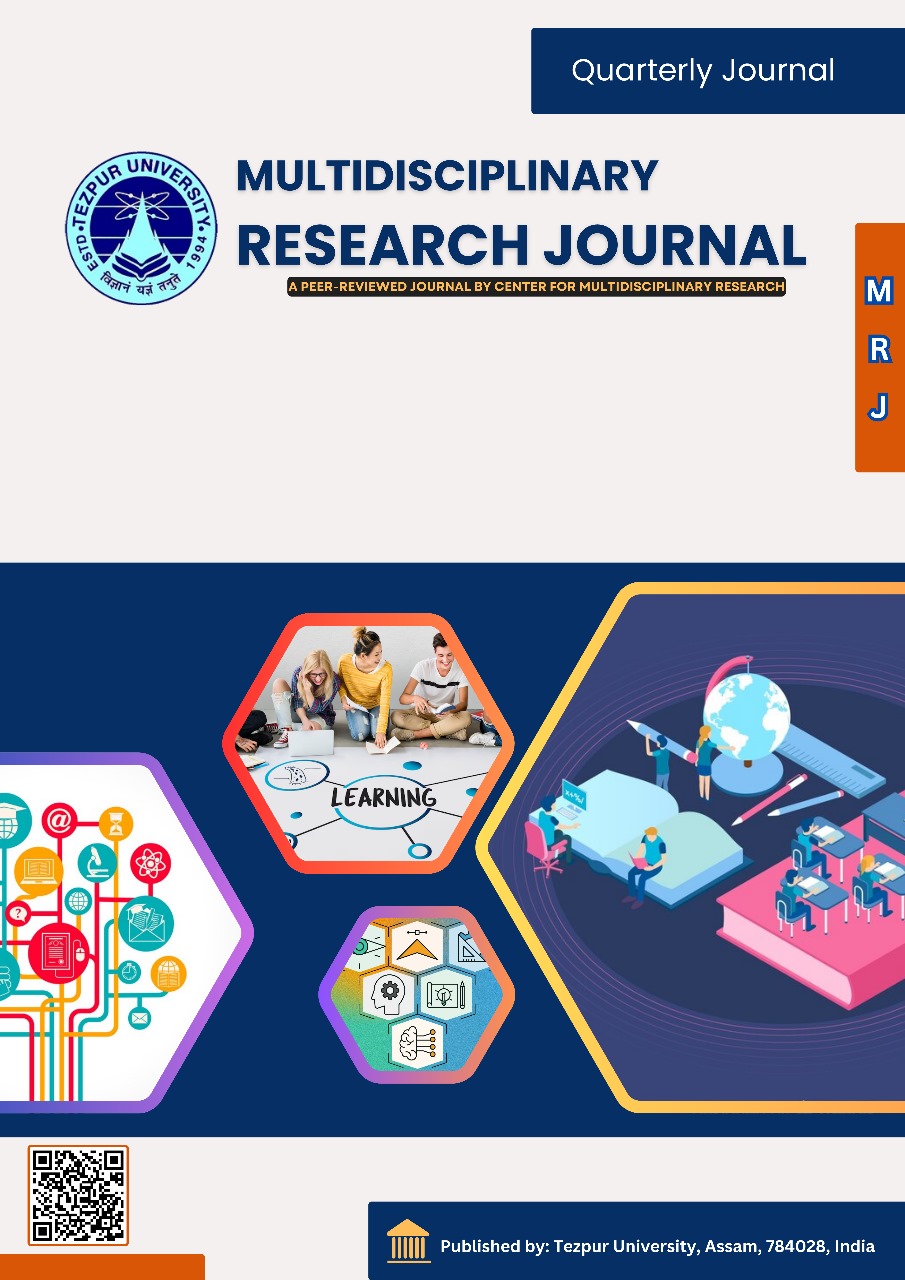What page are we on? Interdisciplinary examples of the ‘what’ and ‘how’ in the ‘doing’
DOI:
https://doi.org/10.63635/mrj.v1i1.4Keywords:
Interdisciplinarity, arts, creativity, education, divergent thinkingAbstract
Interdisciplinarity has always existed in teaching and learning, but through a need to judge or assess student work, disciplines emerged in the 19th century, where subject areas became separate entities. “In ancient times education and philosophy was interdisciplinary (or rather pre-disciplinary) in the sense that philosophers did not accept any boundaries or limitations to the validity of the truths they uncovered by the way of thinking” [Krishnan, 2009, p.13]. More recently, there has been a move back toward interdisciplinarity, but the way is not easy while external structures remain that work against its philosophical values. We have employed a qualitative constructivist framework with an autoethnographic lens to examine a series of workshops that were conducted by the author. This article examines the difficulties that exist in pursuing an interdisciplinary approach, while acknowledging the benefits. Examples are provided of some ‘small steps’ that have been taken in the ‘doing’ as without practical examples, the ‘what’ and ‘how’ are lost and the discussions remain philosophical leaving teachers and academics scratching their heads, wondering how they will do this. The outcome of this approach allows a clear view of what can be achieved when the arts are involved.
Downloads
References
[1] Krishnan, A. What are academic disciplines? Some observations on the Disciplinarity vs. Interdisciplinarity debate. ESRC Nat Centre Res Methods 2009, NCRM Working Paper Series, 3:9, 1-59.
[2] Lee, J. H. Building creative confidence through an interdisciplinary creativity course: Changes in creative challenges and creative personal identity. Innov Educ Teach Int 2022, 59:3, 316-325, https://doi.org/10.1080/14703297.2020.1835689
[3] Sternberg, R. Identifying and developing creative giftedness. Roeper Rev 2000, 32:2, 60-64, https://doi.org/10.1080/02783190009554067
[4] Beaty, R.; Zeitlen, D.; Baker, B.; Kenett, Y. Forward flow and creative thought: Assessing associative cognition and its role in divergent thinking. Think Skills Creat 2021, 41, https://doi.org/10.1016/j.tsc.2021.100859
[5] Rinne, L.; Gregory, E.; Yarmolinskaya, J.; Hardiman, M. Why arts integration improves long term retention of content. Mind Brain Educ 2011, 5:2, 89-96. https://doi.org/10.1111/j.1751-228X.2011.01114.x
[6] Guo, Y.; Lin, S.; Acar, S.; Jin, S.; Xu, X.; Feng, Y; Zeng, Y. Divergent Thinking and Evaluative Skill: A Meta-Analysis. J Creat Behav 2022, 56, 432-448. https://doi.org/10.1002/jocb.539
[7] Felder, R. Creativity in Engineering Education, Views and opinions. Chem Eng Educ, 1988.
[8] Huitt, W.; Monetti, M.; Hummel, J. Direct approach to instruction. In Instructional-Design Theories and Models, Volume III. Routledge, 2009; pp. 85-110.
[9] Bereiter, C.; Scardamalia, M. Learning to work creatively with knowledge, in Unravelling basic components and dimensions of powerful learning environments, EARLI Advances in Learning and instructions series 2003, Pergamon/Elsevier Science, Ltd.
[10] Booth, E. The habits of mind of creative engagement. Available online: https://ericbooth.net/the-habits-of-mind-of-creative-engagement/ (accessed on November 11 2024).
[11] Fosnot, C. Constructivism: Theory, Perspectives, and Practice; Teachers College Press, New York, 2013.
[12] Williamson, K. Research in Constructivist Frameworks Using Ethnographic Techniques. Lib Trends 2006, 55:1, John Hopkins University Press, 83-101, https://doi.org/10.1353/lib.2006.0054
[13] Carbaugh, D. The critical voice in ethnography of communication research. Res Lang Soc Interac 2009, 23:1-4, 261-281, https://doi.org/10.1080/08351818909389324
[14] Altheide, D. Reflections, Ethnographic Content Analysis. Qual Sociol 1987, 10:1, 65-77, https://doi.org/10.1007/BF00988269
[15] Larsen, R.; Walker, K. Learning about the real world in an urban arts youth program. J Adolesc Res 2006, 21:3, 244-268, https://doi.org/10.1177/0743558405285
[16] Ho, R.; Potash, J.; Lo, P.; Wong, V. Holistic interventions to trauma management for teachers following disaster: Expressive arts and Integrated Body Mind Spirit Approaches. Asia Pac J Soc Work Dev 2014, 24:4, 275-284, https://doi.org/10.1080/02185385.2014.925819
[17] Curl, K. Assessing Stress Reduction as a function of artistic creation and cognitive focus. Art Ther 2011, 25:4, 164-169, https://doi.org/10.1080/07421656.2008.10129550
[18] Birman, B.; Desimone, L.; Porter, A.; Garet, M. Designing professional development that works. Educ Leadersh 2000, 57:8, 28-33.
[19] Snook, B. Using the arts across the curriculum: Integrated lesson plans; NZCER Press, 2021, IBSN: 9781988542980
[20] Mart, C. Encouraging young learners to learn English through stories. Engl Lang Teach 2012, 5:5, 101-106, DOI:10.5539/elt.v5n5p101
[21] Eisner, E. Does experience in the arts boost academic achievement? Arts Educ Policy Rev 1998, 100:1, 32-40, https://doi.org/10.1080/00098659909599615
[22] Jacobs, J.; Frickel, S. Interdisciplinarity: A critical Assessment. Annu Rev Sociol 2009, 35, 43-65, https://doi.org/10.1146/annurev-soc-070308-115954
[23] Robson, S. The social cultural and emotional contexts of thinking and understanding. In Developing Thinking and Understanding in Young Children; Routledge, 2012, ISBN 9780203133354, https://doi.org/10.4324/9780203133354
[24] Crosby, S. Preliminary evaluation of a girls’ empowerment program: The effects of dance on self-esteem and body image, Pepperdine University, unpublished thesis, 2013.
[25] Poll, T. Dance, Self Esteem, and Motor Acquisition. J Phys Educ Recreat 1979, 50:1, 64–65. https://doi.org/10.1080/00971170.1979.10617926
[26] Theodorakou, K.; Zervas, Y. The effects of the Creative movement teaching method and the traditional teaching method on elementary school children’s self-esteem. Sport Educ Soc 2003, 8:1, 91-104, https://doi.org/10.1080/1357332032000050088
Downloads
 Abstract Display: 330
Abstract Display: 330  PDF Downloads: 165
PDF Downloads: 165 Published
Issue
Section
License

This work is licensed under a Creative Commons Attribution-NonCommercial 4.0 International License.
Copyright © Author(s) retain the copyright of this article.




